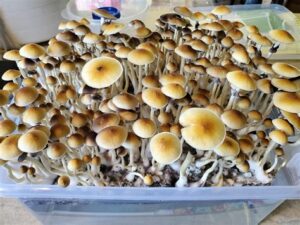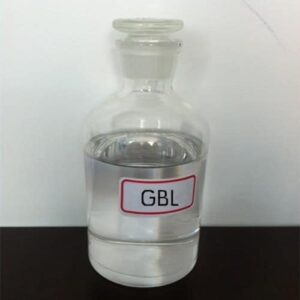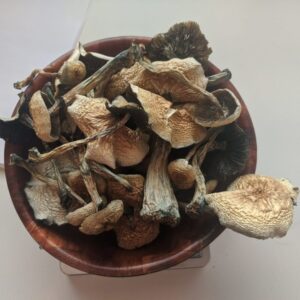Blue Meanie Mushroom: A Guide to the Potent Psychedelic
Blue meanie mushroom is a common name for two different types of mushrooms that contain psilocybin, a psychoactive compound that can induce altered states of consciousness. However, not all blue meanies are the same, and it is important to know the differences between them before consuming them. In this article, we will explore the history, effects, benefits, risks, and cultivation of blue meanie mushroom, focusing on the Psilocybe cubensis strain that is popular among psychedelic enthusiasts.
What is Blue Meanie Mushroom?
Blue meanie mushroom is a strain of Psilocybe cubensis, a species of magic mushroom that grows in tropical and subtropical regions of the world. Psilocybe cubensis is one of the most widely cultivated and consumed species of psychedelic mushrooms, as it is relatively easy to grow and has a moderate potency. There are many varieties of Psilocybe cubensis, each with its own characteristics and effects. Blue meanie mushroom is one of them, and it is named after the blue color of its caps and stems, which comes from the presence of psilocin and psilocybin, the active ingredients that cause the psychedelic effects.
Blue meanie mushroom should not be confused with another mushroom that is also called blue meanie, which is Panaeolus cyanescens, a species of mushroom that belongs to a different genus and has a much higher potency. Panaeolus cyanescens is also known as the “real” blue meanie, as it is the original mushroom that was given this name by Australian mushroom hunters. However, some sources may use the term blue meanie interchangeably for both mushrooms, so it is advisable to check the scientific name before buying or consuming any blue meanie mushroom.
The History of Blue Meanie Mushroom
Blue meanie mushroom, as a strain of Psilocybe cubensis, has a long history of use by indigenous peoples in Central and South America, who have used it for religious and healing purposes for thousands of years. The mushroom was first scientifically described by American mycologist Rolf Singer in 1948, who named it Stropharia cubensis. Later, it was reclassified as Psilocybe cubensis by another American mycologist, Gastón Guzmán, in 1962.
The blue meanie mushroom strain was first discovered in Australia, where it is believed to have originated from a wild variety of Psilocybe cubensis. The name “blue meanie” was popularized in the 1970s by the Beatles movie “Yellow Submarine”, in which the blue meanies were depicted as villains. Since then, the name has been used to refer to various strains of blue-colored mushrooms, including Psilocybe cubensis and Panaeolus cyanescens.
Blue meanie mushroom, along with other psilocybin mushrooms, became popular in the 1960s and 1970s as part of the psychedelic movement, which advocated the use of hallucinogens for personal and social transformation. However, the mushroom was also subjected to legal restrictions and prohibition in many countries, as it was classified as a Schedule I drug by the United Nations Convention on Psychotropic Substances in 1971. Despite the legal challenges, blue meanie mushroom and other psilocybin mushrooms have continued to be used by recreational and medicinal users, as well as by researchers and therapists who are exploring the potential benefits of psilocybin for various mental health conditions.
The Effects of Blue Meanie Mushroom
Blue meanie mushroom, as a type of psilocybin mushroom, produces a range of effects on the mind and body, depending on the dose, individual factors, and environmental factors. The effects typically last between 4 to 6 hours, with the peak occurring 2 to 3 hours after ingestion. Some of the common effects of blue meanie mushroom are:
Physical Effects
- Dilated pupils
- Increased heart rate and blood pressure
- Nausea and vomiting
- Increased sensitivity to touch and sound
- Sweating and chills
Psychological Effects
- Changes in perception, including visual and auditory hallucinations
- Euphoria and feelings of well-being
- Intense emotions, both positive and negative
- Altered sense of time and space
- Mystical or spiritual experiences
The effects of blue meanie mushroom can vary from person to person, and from trip to trip, depending on the dosage, tolerance, mindset, and setting. Some people may experience more pleasant and positive effects, while others may experience more unpleasant and negative effects, such as anxiety, paranoia, confusion, and panic. Therefore, it is important to take blue meanie mushroom in a safe and comfortable environment, with trusted friends or a sitter, and to start with a low dose and increase gradually.
The Benefits of Blue Meanie Mushroom
While more research is needed to fully understand the therapeutic potential of blue meanie mushroom, some people believe that it may have the following benefits:
- Relief from anxiety, depression, and other mental health conditions
- Increased creativity and problem-solving abilities
- Enhanced spirituality and personal growth
- Reduced addiction to harmful substances
- Relief from cluster headaches and migraines
Some of these benefits are supported by scientific evidence, as psilocybin, the active ingredient in blue meanie mushroom, has been shown to have positive effects on mood, cognition, and neuroplasticity in several clinical trials. Psilocybin has also been granted a breakthrough therapy designation by the US Food and Drug Administration (FDA) for the treatment of major depressive disorder and treatment-resistant depression. However, more studies are needed to confirm the safety and efficacy of psilocybin and blue meanie mushroom for various medical conditions, and to determine the optimal dosage and administration methods.
The Risks and Precautions of Blue Meanie Mushroom
While blue meanie mushroom can be a powerful and transformative experience, it is also essential to take certain precautions to ensure your safety. Here are some things to keep in mind:
- Only take blue meanie mushroom in a safe and comfortable environment, with trusted friends or a sitter, who can help you in case of any physical or psychological issues.
- Start with a low dose and increase gradually, as the effects of blue meanie mushroom can be unpredictable and vary from person to person. A typical dose of blue meanie mushroom is between 1 to 3 grams, depending on your body weight, tolerance, and desired effects.
- Avoid mixing blue meanie mushroom with other drugs or alcohol, as this can increase the risk of adverse reactions and interactions.
- Do not take blue meanie mushroom if you have a history of psychosis, schizophrenia, bipolar disorder, or other mental health conditions, as this can trigger or worsen your symptoms.
- Do not take blue meanie mushroom if you are pregnant, breastfeeding, or planning to become pregnant, as this can harm your baby.
- Do not take blue meanie mushroom if you are allergic to mushrooms or have a compromised immune system, as this can cause serious infections or allergic reactions.
- Be aware of the legal status of blue meanie mushroom in your country or region, as it is illegal to buy, sell, or possess in most jurisdictions. Do not do anything that results in your going to prison.
How to Grow Blue Meanie Mushroom
If you want to grow your own blue meanie mushroom, you will need some equipment and materials, as well as some patience and care. Here are the steps to follow:
Equipment Needed
- A pressure cooker or a large pot with a lid
- A glass jar with a metal lid
- A drill and a small drill bit
- A syringe with a needle
- A spore print or a spore syringe of blue meanie mushroom
- A substrate, such as brown rice flour, vermiculite, and water
- A sterilized container, such as a plastic shoebox or a plastic bag
- A spray bottle with distilled water
- A heating pad or a warm place
- A sharp knife
- A dehydrator or a fan
Step-by-Step Growing Process
- Drill four small holes in the lid of the glass jar, evenly spaced around the edge.
- Mix the substrate ingredients in a bowl, using the ratio of 2 parts vermiculite, 1 part brown rice flour, and 1 part water. The mixture should be moist but not soggy.
- Fill the jar with the substrate mixture, leaving about an inch of space at the top. Do not pack the substrate too tightly, as it needs some air to breathe.
- Wipe the rim of the jar with a clean cloth and screw the lid on loosely.
- Place the jar in the pressure cooker or the pot with water, and bring it to a boil. Sterilize the jar for at least an hour, then let it cool down completely.
- Inject the spores of blue meanie mushroom into the jar through the holes in the lid, using the syringe. Use about 1 ml of spore solution per hole, and shake the jar gently to distribute the spores.
- Place the jar in a dark and warm place, such as a closet or a cabinet, and wait for the mycelium to grow. The mycelium is the white, fuzzy, root-like structure of the mushroom, and it should cover the entire substrate in about 2 to 4 weeks.
- Once the mycelium has fully colonized the substrate, it is time to initiate the fruiting stage. Transfer the substrate to a sterilized container, such as a plastic shoebox or a plastic bag, and expose it to light and fresh air. You can also add a layer of moist vermiculite on top of the substrate to create a humid and nutritious environment for the mushrooms to grow. Spray the container with distilled water every day to keep it moist, but not wet.








ammira –
Trippy today thanks for making my life better, i had doubts but no more. you got a client for life
colbert weize –
Excellent customer service, quality content and above all great products. I’ll always come back for more